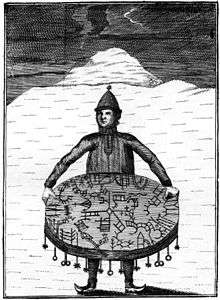Noaidi
A noaidi (Northern Sami: noaidi, Lule Sami: noajdde, Southern Sami: nåejttie, Skolt Sami: nōjjd, Ter Sami: niojte, Kildin Sami: noojd/nuojd) is a shaman of the Sami people in the Nordic countries representing an indigenous nature religion. Most noaidi practices died out during the 17th century, most likely because they resisted Christianisation and the king's authority. Their actions were referred to in courts as "magic" or "sorcery" (cf. witchcraft). Several Sámi shamanistic beliefs and practices were similar to those of some Siberian cultures.[1]

Description and history
Noaidis, Sámi shamans, were traditionally the healers and protectors. Noaidis are said to have the role of mediator between humans and the spirits. To undertake this mediation, the noaidi communicated with the spirit world, asking what sacrifice needed to be made by a person so that they might return to good health, be successful in their hunt for food, and even for good weather. Sacrifices were designed by the noaidi to reestablish the balance between the mortal and immortal worlds. Using a traditional drum, which is the most important symbol and tool of the Sámi shaman, the noaide invoked assistance from benevolent spirits and conducted out-of-body travel via the “free soul” with the help of other siida members. The Sámi distinguish between the “free soul” versus the more mundane “body soul”; the “body soul” is unable to traverse the divide separating the spiritual netherworld from the more mundane, corporeal, real world.[2]
A noaidi could engage in any kind of affair that demanded wisdom; it is said they took payments for their services. The activities included healing people, helping children, making decisions and protecting reindeer, which represented the most important source of food and were also used as tribute payment.
The sources from which we learn about noaidi are court protocols, tales, excavated tools (such as belts), and missionary reports. That noaidis were punished and in some cases sentenced to death for their "sorcery" should perhaps rather be interpreted as an attempt to obliterate opposition to the crown. There was by law no freedom of religion during most of the 19th century and before, as the Lutheran Swedish church was the only allowed religion (except for some foreign temporary residents). Swedish priests supported conviction of noaidis for sorcery.
Remnants in music tradition
In the Sami shamanistic form of worship drumming and traditional chanting (joiking) were of singular importance.[2] Some of joiks were sung on shamanistic rites;[3] this memory is conserved also in a folklore text (a shaman story).[4][3]
Recently, joiks have been sung in two different styles, one of which is sung only by young people. The other joik may be identified with the “mumbling” joik, resembling chants or magic spells.[5]
Several surprising characteristics of joiks can be explained by comparing the music ideals, as observed in joiks and contrasted to music ideals of other cultures. In some instances, joiks mimic natural sounds. This can be contrasted to other goals, namely overtone singing and bel canto, both of which exploit human speech organs to achieve “superhuman” sounds.[6] Overtone singing and the imitation of sounds in shamanism are present in many other cultures as well.[7][8] Sound imitation may serve other purposes such as games and other entertainment[9][10] as well as important practical purposes such as luring animals during hunts.[9]
Notes
- Voigt 1966: 296
- Holloway, Alan “Ivvár”. "The Decline of the Sámi People's Indigenous Religion". TexasU.
- Szomjas-Schiffert 1996: 56, 76
- Voigt 1966: 145
- Szomjas-Schiffert 1996: 64
- Szomjas-Schiffert 1996: 74
- Hoppál 2006: 143 Archived 2015-04-02 at the Wayback Machine
- Diószegi 1960: 203
- Nattiez: 5
- Deschênes 2002
References
- Deschênes, Bruno (2002). "Inuit Throat-Singing". Musical Traditions. The Magazine for Traditional Music Throughout the World.
- Diószegi, Vilmos (1960). Sámánok nyomában Szibéria földjén. Egy néprajzi kutatóút története (in Hungarian). Budapest: Magvető Könyvkiadó. The book has been translated to English: Diószegi, Vilmos (1968). Tracing shamans in Siberia. The story of an ethnographical research expedition. Translated from Hungarian by Anita Rajkay Babó. Oosterhout: Anthropological Publications.
- Hoppál, Mihály (2005). Sámánok Eurázsiában (in Hungarian). Budapest: Akadémiai Kiadó. ISBN 963-05-8295-3. The title means “Shamans in Eurasia”, the book is published also in German, Estonian and Finnish. Site of publisher with short description on the book (in Hungarian).
- Hoppál, Mihály (2006). "Music of Shamanic Healing" (PDF). In Gerhard Kilger (ed.). Macht Musik. Musik als Glück und Nutzen für das Leben. Köln: Wienand Verlag. ISBN 3-87909-865-4.
- Nattiez, Jean Jacques. "Inuit Games and Songs • Chants et Jeux des Inuit". Musiques & musiciens du monde • Musics & musicians of the world. Montreal: Research Group in Musical Semiotics, Faculty of Music, University of Montreal. Cite journal requires
|journal=(help). The songs are online available from the ethnopoetics website curated by Jerome Rothenberg. - Szomjas-Schiffert, György (1996). Lapp sámánok énekes hagyománya • Singing tradition of Lapp shamans (in Hungarian and English). Budapest: Akadémiai Kiadó. ISBN 963-05-6940-X.
- Voigt, Vilmos (1966). A varázsdob és a látó asszonyok. Lapp népmesék. Népek meséi (in Hungarian). Budapest: Európa Könyvkiadó. The title means: “The magic drum and the clairvoyant women. Sami folktales”, the series means: “Tales of folks”.